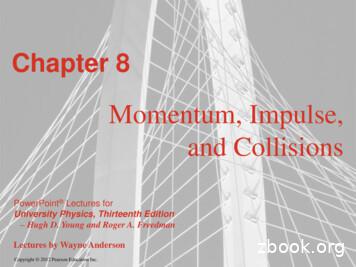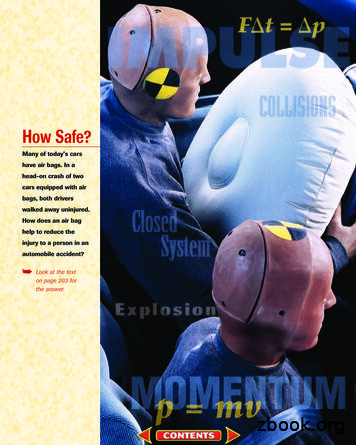Chapter 3 Momentum And Impulse - Yslphysics.weebly
CHAPTER 3 MOMENTUM AND IMPULSE 1prepared by Yew Sze Ling@Fiona, KMLChapter 3 Momentum and ImpulseCurriculum Specification3.1Momentum and impulse a) Define momentum and impulse, J F t . (C1, C2)b) Solve problem related to impulse and impulse momentum theorem, J p mv f mvi . (C3, C4)c) Use F-t graph to determine impulse. (C3, C4)3.2Conservation of linear momentuma) State the principle of conservation of linear momentum(C1, C2)b) Apply the principle of conservation of momentum inelastic and inelastic collisions in 1D and 2D collisions.(C3, C4)c) Differentiate elastic and inelastic collisions. (C3, C4)RemarksBeforeAfterRevision
CHAPTER 3 MOMENTUM AND IMPULSE 2prepared by Yew Sze Ling@Fiona, KML3.1Momentum and ImpulseMomentum The linear momentum (or “momentum” for short) of an object is defined as the product of itsmass and its velocity. p mv SI unit of momentum: kg m s -1 or N s Momentum is vector quantity that has the same direction as the velocity.Since momentum is a vector quantity, it has direction and can be resolved into x and ycomponent. Consider a momentum p at an angle θ from the horizontal.pyp x mv x mv cos θ p y mv y mv sin pxThe more momentum the object has, the harder it is to stop it, and the greater effect it will haveon another object if it is brought to rest by striking the object.2000 kg moving at 5 m s-10.02 kg moving at 400 m s-1Both are hard to stop because both have great momentum. Charging elephant has great mass,single bullet has high velocity.Impulse The impulse of a force is the product of the average force and the time interval during which theforce acts. J F t SI unit of impulse: kg m s -1 or N s Impulse is a vector quantity whose direction is the same as the constant force on the objectF-t Graph If the force varies with time as shown in Figure below, impulse is equal to the shaded area underF –t graph.approximateArea F Δt
CHAPTER 3 MOMENTUM AND IMPULSE 3prepared by Yew Sze Ling@Fiona, KMLImpulse-Momentum Theorem When a net average force ̅⃗ acts on an object during a time interval Δt, the impulse ⃗ of thisforce is equal to the change in momentum Δ ⃗⃗ of the object: J p F t mv f mvi Impulse onnailImpulse onhammerImpulse – momentum relationship:muIf the change in momentum occurs over a long time, the force of impact is small.muIf the change in momentum occurs over a short time, the force of impact is large. Besides, same impulse does not mean same amount of force or the same amount of time. Itmeans the same product of force and time. For example:Egg breaks!Egg survives!ConclusionEven though the impulse are the same in both object cases, object with larger time in contactwill experience less damage compare to the object with shorter time in contact.
CHAPTER 3 MOMENTUM AND IMPULSE 4prepared by Yew Sze Ling@Fiona, KML3.2Conservation of Linear Momentum Principle of conservation of linear momentum states that the total linear momentum of anisolated system remains constant (is conserved). pf pim1v f 1 m2 v f 2 m1vi1 m2 vi 2 An isolated system is one for which the vector sum of the average external forces acting on thesystem is zero.Collision in One Dimensional MotionElastic collisionInelastic collisionPerfectly inelastic collisionTotal momentum is conserved:Total momentum is conserved:Total momentum is conserved: p p p p p pifm1u1 m2 u2 m1v1 m2 v2Total kinetic energy isconserved: K Kiifim1u1 m2 u2 m1 m2 vm1u1 m2 u2 m1v1 m2 v2Total kinetic energy is NOT conserved: K KifNo loss of kinetic energy inthe collision.f fSome of the initial kinetic energy is transformed into anothertype of energy such as heat energy due to friction.The total kinetic energy after the collision is less than the totalkinetic energy before the collision.However, total energy is conserved.Caution: It is a common misconception that the only inelastic collisions are those in which thecolliding bodies stick together. In fact inelastic collisions include many situations in which thebodies do not stick.K.E. is conservedK.E. is NOT conserved
CHAPTER 3 MOMENTUM AND IMPULSE 5prepared by Yew Sze Ling@Fiona, KMLOther example of 1D collision: ExplosionTotal momentum is conserved:m2v1 p pv2im1m1f0 m1v1 m2 v2m2u 0 m s-1Total kinetic energy is NOT conserved: K KifCollision in Two Dimensional Motions For collision in two dimensions, we MUST conserve the momentum component by component. To do this we set up a coordinates system and resolve the velocities into x and y component.Example:Momentum along x-axis:m1m2Initially, object m1 is moving with velocity u1 alongthe x axis only.Momentum along y-axis:After the collision, two objects move off in differentdirection. Thus, we have to resolve the velocities(vector) into x and y component.Additional Knowledge: Coefficient of restitution(Not in Syllabus)When there is a head on collision between two bodies, the ratio of their relative velocity aftercollision and their relative velocity before collision is called the coefficient of restitution. Thuse v 2 v1u 2 u1For (perfectly) elastic collision, e 1If 0 e 1, then the collision is inelastic (objects do not stick together after collision)For perfectly inelastic collision, e 0 (objects stick together after collision)
CHAPTER 3 MOMENTUM AND IMPULSE 6prepared by Yew Sze Ling@Fiona, KMLExerciseMomentum and Impulse1.A 1.5 kg ball was kicked with initial velocity of 40 m s-1 at the angle 30 with the horizontalline. Calculate the momentum of the ball and also the horizontal and vertical components of themomentum.2.A 46-kg skater is standing still in front of a wall. By pushing against the wall she propelsherself backward with a velocity of ‒1.2 m/s. Her hands are in contact with the wall for 0.80 s.Ignore friction and wind resistance. Find the magnitude and direction of the average force sheexerts on the wall3.A constant friction force of 25 N acts on a 65.0 kg skier for 15 s on level snow. What is theskier’s change in velocity?4.A golf ball strikes a hard, smooth floor at an angle of 30.0 and,as the drawing shows, rebounds at the same angle. The mass ofthe ball is 0.047 kg, and its speed is 45 m s-1 just before and afterstriking the floor. What is the magnitude of the impulse applied tothe golf ball by the floor?(Hint: Note that only the vertical component of the ball’smomentum changes during impact with the floor)5.The graph shows the force acting on a tennis ball of mass 60 g during a return shot.200 Na. What is the impulse on the ball?b. If the ball reaches the player with velocity of 22 m s -1 moving to the left, what is thevelocity of the return shot to the right?Conservation of Linear Momentum1.A 5.00-kg ball, moving to the right at a velocity of 2.00 m s-1 on a frictionless table, collideshead-on with a stationary 7.50-kg ball. Find the final velocities of the balls if the collision isa. elasticb. completely inelastic2.A two-stage rocket moves in space at a constant velocity of 4900 m s-1. The two stages are thenseparated by a small explosive charge placed between them. Immediately after the explosionthe velocity of the 1200 kg upper stage is 5700 m s-1 in the same direction as before theexplosion. What is the velocity (magnitude and direction) of the 2400 kg lower stage after theexplosion?3.An object A of mass 2.0 kg moves to the right at a speed of 5.0 m s-1. Object B of mass 4.0 kgmoves to the left at a speed of 8.0 m s-1. Determine the velocity of A and B after the head-oncollision, assuming that the collision is elastic.
CHAPTER 3 MOMENTUM AND IMPULSE 7prepared by Yew Sze Ling@Fiona, KML4.By accident, a large plate is dropped vertically and breaks into threepieces. The pieces fly apart parallel to the floor. Using the datashown in the drawing, find the masses of pieces 1 and 2.5.The drawing shows a collision between two pucks on an airhockey table. Puck A has a mass of 0.025 kg and is movingalong the x-axis with a velocity of 5.5 m s-1. It makes acollision with puck B, which has a mass of 0.050 kg and isinitially at rest. The collision is not head-on. After thecollision, the two pucks fly apart with the angles shown in thedrawing. Find the final speeds ofa. puck Ab. puck B6.A mine car (mass 440 kg) rolls at a speed of 0.50 m s-1 on ahorizontal track, as the drawing shows. A 150 kg chunk of coalhas a speed of 0.80 m s-1 when it leaves the chute. Determine thespeed of the car–coal system after the coal has come to rest in thecar.HOTS Questions1.A neon atom (m 20.0 u) makes a perfectly elastic collision with another atom at rest. Afterthe impact, the neon atom travels away at a 55.6 angle from its original direction and theunknown atom travels away at a angle ‒55.0 . What is the mass (in u) of the unknown atom?2.A 0.25 kg skeet (clay target) is fired at an angle of 28 to the horizontal with a speed of 25 m s -1(Figure). When it reaches the maximum height, h, it is hit from below by a 15 g pellet travelingvertically upward at a speed of 230 m s-1. The pellet is embedded in the skeet.a. How much higher, h’, does the skeet go up?b. How much extra distance, Δx, does the skeet travel because of the collision?
CHAPTER 3 MOMENTUM AND IMPULSE prepared by Yew Sze Ling@Fiona, KML 2 3.1 Momentum and Impulse Momentum The linear momentum (or "momentum" for short) of an object is defined as the product of its mass and its velocity. p mv & & SI unit of momentum: kgms-1 or Ns Momentum is vector quantity that has the same direction as the velocity.
1. Impulse and Momentum: You should understand impulse and linear momentum so you can: a. Relate mass, velocity, and linear momentum for a moving body, and calculate the total linear momentum of a system of bodies. Just use the good old momentum equation. b. Relate impulse to the change in linear momentum and the average force acting on a body.
Impulse and momentum The impulse of a force is the product of the force and the time interval during which it acts. On a graph of F x versus time, the impulse is equal to the area under the curve, as shown in figure to the right. Impulse-momentum theorem: The change in momentum of a particle during a time interval
Momentum Impulse Newton Graphing Impulse The simple definition for impulse is that it is a change in momentum. If an object’s velocity changes, there is a change in momentum, so there must be an impulse We assume that you are not going to change the mass of an object. Δp m Δv Δp impulse (change
Lecture L10 - Angular Impulse and Momentum for a Particle In addition to the equations of linear impulse and momentum considered in the previous lecture, there is a parallel set of equations that relate the angular impulse and momentum. Angular Momentum We consider a particle of mass m,
1, which expresses the change in momentum of the tennis ball. Thus, the impulse on an object is equal to the change in its mo mentum. Impulse-Momentum Theorem F t p 2 p 1 This equation is called the impulse-momentum theorem.The impulse on an object is equal to the chan
6.1 Momentum and Impulse ! Impulse – In the initial seconds of a collision, there is an impulse force on the object. ! This force is defined as the change in linear momentum: ! In order to change the momentum of an object, a force must be applied. ! The time rate of change of momentum of
Physics 101: Lecture 9, Pg 3 Momentum and Impulse Momentum p mv »Momentum is a VECTOR Impulse I FDt » Impulse is just the
vocabulary materials such as graded readers, which go up through approximately the 4,000-word-family level, to more challenging texts such as newspapers, classic novels, and academic texts, at the .























